wheel BMW X5 4.8IS 2005 E53 Owner's Manual
[x] Cancel search | Manufacturer: BMW, Model Year: 2005, Model line: X5 4.8IS, Model: BMW X5 4.8IS 2005 E53Pages: 200, PDF Size: 3.55 MB
Page 4 of 200
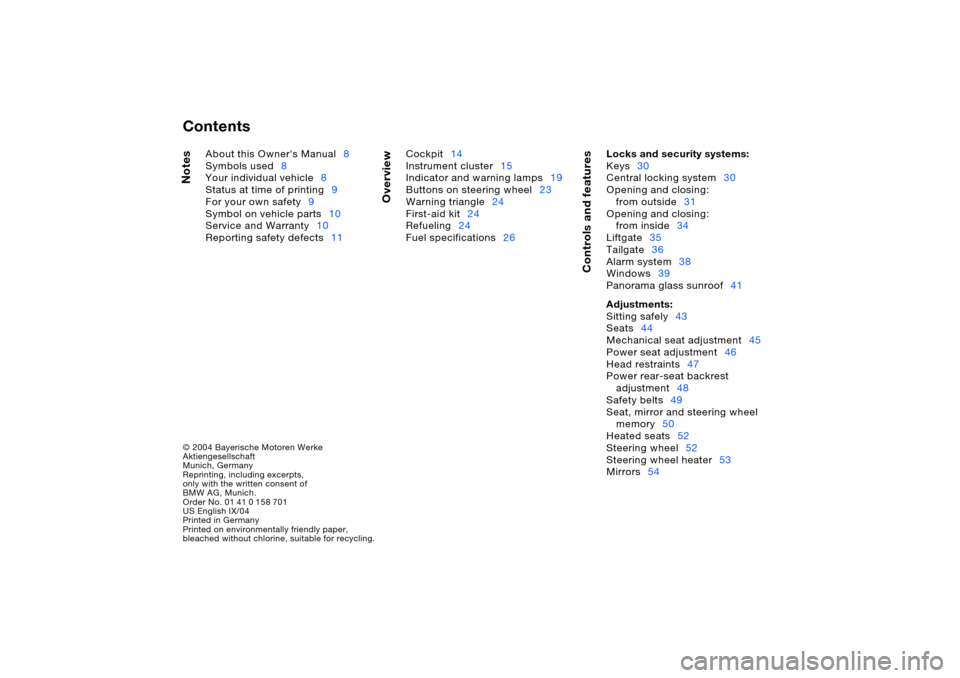
Contents© 2004 Bayerische Motoren Werke
Aktiengesellschaft
Munich, Germany
Reprinting, including excerpts,
only with the written consent of
BMW AG, Munich.
Order No. 01 41 0 158 701
US English IX/04
Printed in Germany
Printed on environmentally friendly paper,
bleached without chlorine, suitable for recycling.Notes
Overview
Controls and features
About this Owner's Manual8
Symbols used8
Your individual vehicle8
Status at time of printing9
For your own safety9
Symbol on vehicle parts10
Service and Warranty10
Reporting safety defects11Cockpit14
Instrument cluster15
Indicator and warning lamps19
Buttons on steering wheel23
Warning triangle24
First-aid kit24
Refueling24
Fuel specifications26Locks and security systems:
Keys30
Central locking system30
Opening and closing:
from outside31
Opening and closing:
from inside34
Liftgate35
Tailgate36
Alarm system38
Windows39
Panorama glass sunroof41
Adjustments:
Sitting safely43
Seats44
Mechanical seat adjustment45
Power seat adjustment46
Head restraints47
Power rear-seat backrest
adjustment48
Safety belts49
Seat, mirror and steering wheel
memory50
Heated seats52
Steering wheel52
Steering wheel heater53
Mirrors54
Page 6 of 200
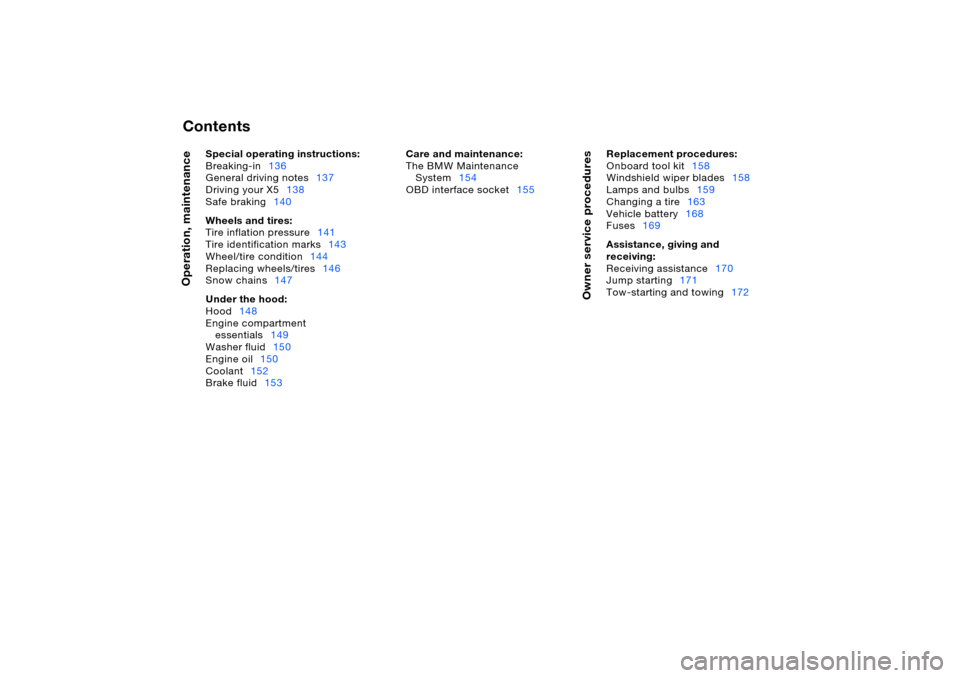
ContentsOperation, maintenance
Owner service procedures
Special operating instructions:
Breaking-in136
General driving notes137
Driving your X5138
Safe braking140
Wheels and tires:
Tire inflation pressure141
Tire identification marks143
Wheel/tire condition144
Replacing wheels/tires146
Snow chains147
Under the hood:
Hood148
Engine compartment
essentials149
Washer fluid150
Engine oil150
Coolant152
Brake fluid153Care and maintenance:
The BMW Maintenance
System154
OBD interface socket155Replacement procedures:
Onboard tool kit158
Windshield wiper blades158
Lamps and bulbs159
Changing a tire163
Vehicle battery168
Fuses169
Assistance, giving and
receiving:
Receiving assistance170
Jump starting171
Tow-starting and towing172
Page 10 of 200
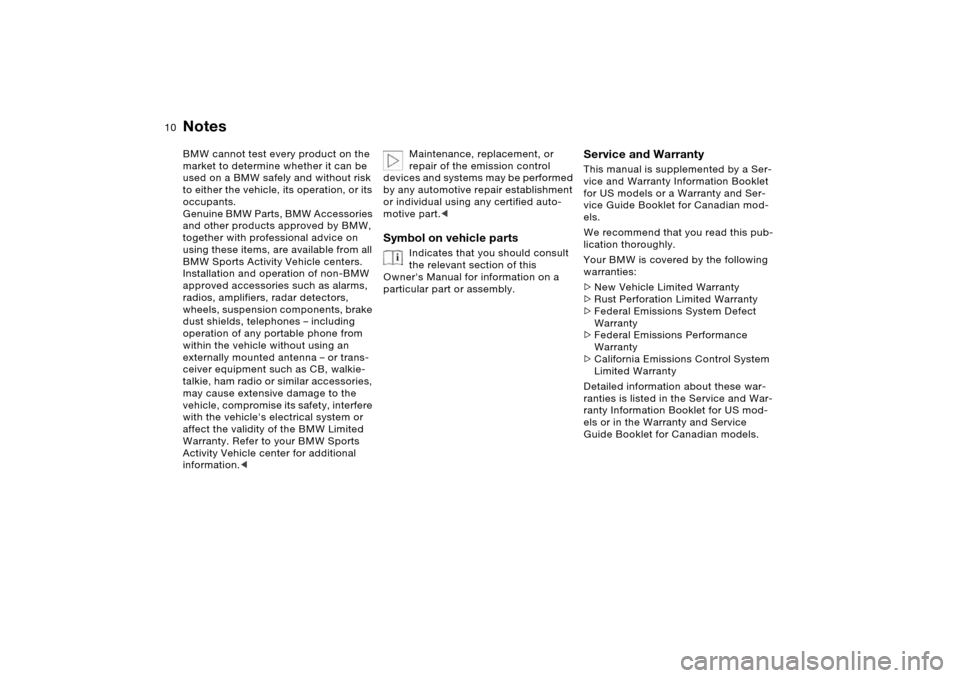
10n
NotesBMW cannot test every product on the
market to determine whether it can be
used on a BMW safely and without risk
to either the vehicle, its operation, or its
occupants.
Genuine BMW Parts, BMW Accessories
and other products approved by BMW,
together with professional advice on
using these items, are available from all
BMW Sports Activity Vehicle centers.
Installation and operation of non-BMW
approved accessories such as alarms,
radios, amplifiers, radar detectors,
wheels, suspension components, brake
dust shields, telephones – including
operation of any portable phone from
within the vehicle without using an
externally mounted antenna – or trans-
ceiver equipment such as CB, walkie-
talkie, ham radio or similar accessories,
may cause extensive damage to the
vehicle, compromise its safety, interfere
with the vehicle's electrical system or
affect the validity of the BMW Limited
Warranty. Refer to your BMW Sports
Activity Vehicle center for additional
information.< Maintenance, replacement, or
repair of the emission control
devices and systems may be performed
by any automotive repair establishment
or individual using any certified auto-
motive part.<
Symbol on vehicle parts
Indicates that you should consult
the relevant section of this
Owner's Manual for information on a
particular part or assembly.
Service and WarrantyThis manual is supplemented by a Ser-
vice and Warranty Information Booklet
for US models or a Warranty and Ser-
vice Guide Booklet for Canadian mod-
els.
We recommend that you read this pub-
lication thoroughly.
Your BMW is covered by the following
warranties:
>New Vehicle Limited Warranty
>Rust Perforation Limited Warranty
>Federal Emissions System Defect
Warranty
>Federal Emissions Performance
Warranty
>California Emissions Control System
Limited Warranty
Detailed information about these war-
ranties is listed in the Service and War-
ranty Information Booklet for US mod-
els or in the Warranty and Service
Guide Booklet for Canadian models.
Page 14 of 200
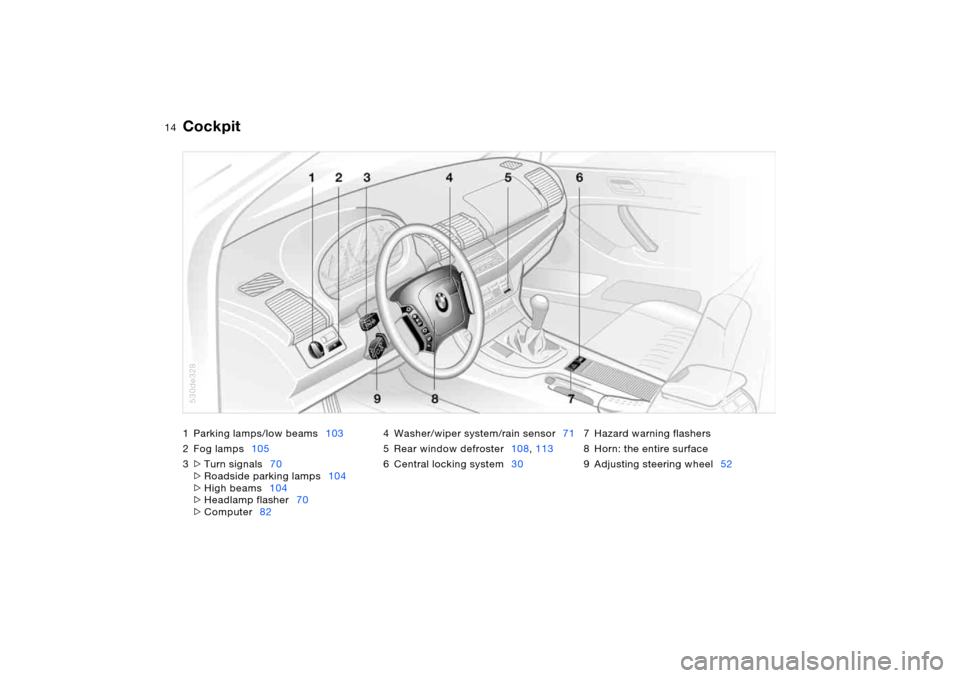
14n
1 Parking lamps/low beams103
2Fog lamps105
3>Turn signals70
>Roadside parking lamps104
>High beams104
>Headlamp flasher70
>Computer824 Washer/wiper system/rain sensor71
5Rear window defroster108, 113
6 Central locking system307 Hazard warning flashers
8 Horn: the entire surface
9 Adjusting steering wheel52
Cockpit
530de328
Page 22 of 200
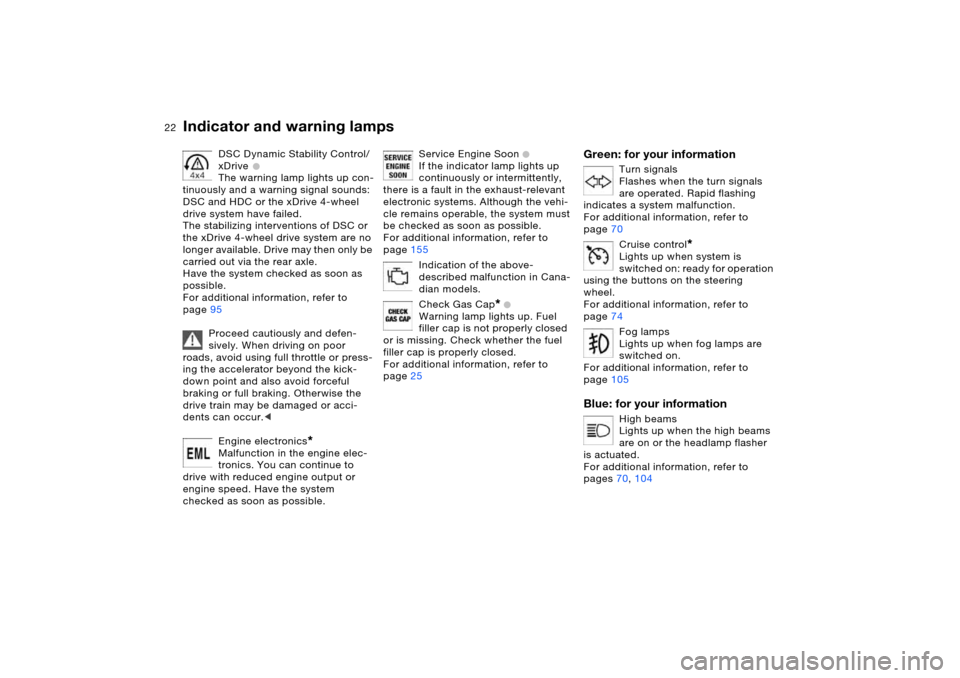
22n
Indicator and warning lamps
DSC Dynamic Stability Control/
xDrive
+
The warning lamp lights up con-
tinuously and a warning signal sounds:
DSC and HDC or the xDrive 4-wheel
drive system have failed.
The stabilizing interventions of DSC or
the xDrive 4-wheel drive system are no
longer available. Drive may then only be
carried out via the rear axle.
Have the system checked as soon as
possible.
For additional information, refer to
page95
Proceed cautiously and defen-
sively. When driving on poor
roads, avoid using full throttle or press-
ing the accelerator beyond the kick-
down point and also avoid forceful
braking or full braking. Otherwise the
drive train may be damaged or acci-
dents can occur.<
Engine electronics
*
Malfunction in the engine elec-
tronics. You can continue to
drive with reduced engine output or
engine speed. Have the system
checked as soon as possible.
Service Engine Soon
+
If the indicator lamp lights up
continuously or intermittently,
there is a fault in the exhaust-relevant
electronic systems. Although the vehi-
cle remains operable, the system must
be checked as soon as possible.
For additional information, refer to
page155
Indication of the above-
described malfunction in Cana-
dian models.
Check Gas Cap
* +
Warning lamp lights up. Fuel
filler cap is not properly closed
or is missing. Check whether the fuel
filler cap is properly closed.
For additional information, refer to
page25
Green: for your information
Turn signals
Flashes when the turn signals
are operated. Rapid flashing
indicates a system malfunction.
For additional information, refer to
page70
Cruise control
*
Lights up when system is
switched on: ready for operation
using the buttons on the steering
wheel.
For additional information, refer to
page74
Fog lamps
Lights up when fog lamps are
switched on.
For additional information, refer to
page105
Blue: for your information
High beams
Lights up when the high beams
are on or the headlamp flasher
is actuated.
For additional information, refer to
pages70, 104
Page 23 of 200
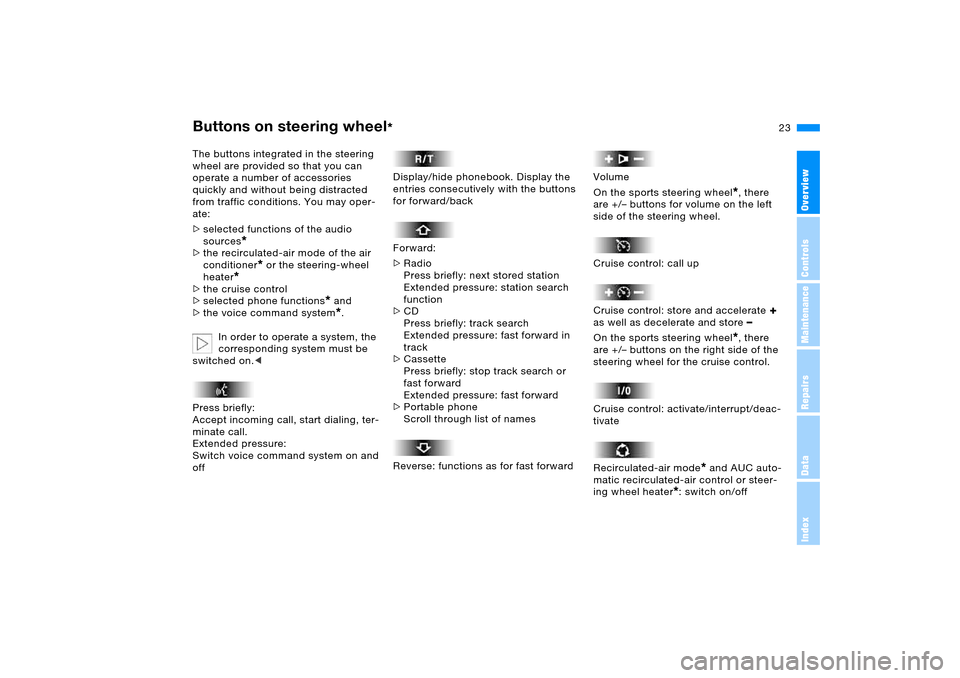
23n
OverviewControlsMaintenanceRepairsDataIndex
Buttons on steering wheel
*
The buttons integrated in the steering
wheel are provided so that you can
operate a number of accessories
quickly and without being distracted
from traffic conditions. You may oper-
ate:
>selected functions of the audio
sources
*
>the recirculated-air mode of the air
conditioner
* or the steering-wheel
heater
*
>the cruise control
>selected phone functions
* and
>the voice command system*.
In order to operate a system, the
corresponding system must be
switched on.<
Press briefly:
Accept incoming call, start dialing, ter-
minate call.
Extended pressure:
Switch voice command system on and
off
Display/hide phonebook. Display the
entries consecutively with the buttons
for forward/back
Forward:
>Radio
Press briefly: next stored station
Extended pressure: station search
function
>CD
Press briefly: track search
Extended pressure: fast forward in
track
>Cassette
Press briefly: stop track search or
fast forward
Extended pressure: fast forward
>Portable phone
Scroll through list of names
Reverse: functions as for fast forward
Volume
On the sports steering wheel
*, there
are +/– buttons for volume on the left
side of the steering wheel.
Cruise control: call up
Cruise control: store and accelerate
+
as well as decelerate and store
–
On the sports steering wheel
*, there
are +/– buttons on the right side of the
steering wheel for the cruise control.
Cruise control: activate/interrupt/deac-
tivate
Recirculated-air mode
* and AUC auto-
matic recirculated-air control or steer-
ing wheel heater
*: switch on/off
Page 38 of 200
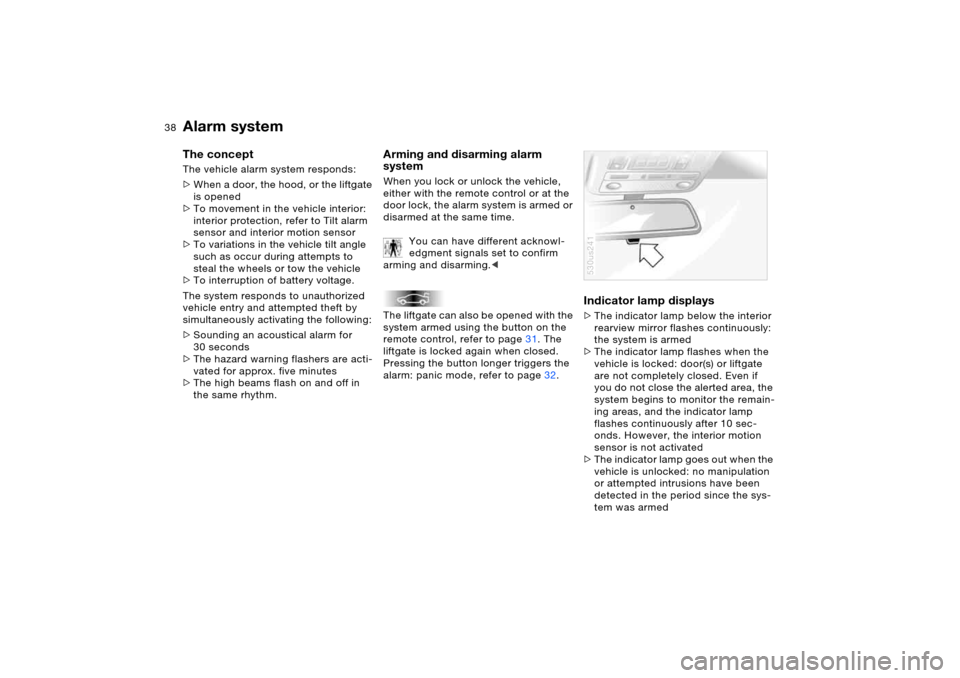
38n
Alarm system The concept The vehicle alarm system responds:
>When a door, the hood, or the liftgate
is opened
>To movement in the vehicle interior:
interior protection, refer to Tilt alarm
sensor and interior motion sensor
>To variations in the vehicle tilt angle
such as occur during attempts to
steal the wheels or tow the vehicle
>To interruption of battery voltage.
The system responds to unauthorized
vehicle entry and attempted theft by
simultaneously activating the following:
>Sounding an acoustical alarm for
30 seconds
>The hazard warning flashers are acti-
vated for approx. five minutes
>The high beams flash on and off in
the same rhythm.
Arming and disarming alarm
system When you lock or unlock the vehicle,
either with the remote control or at the
door lock, the alarm system is armed or
disarmed at the same time.
You can have different acknowl-
edgment signals set to confirm
arming and disarming.<
The liftgate can also be opened with the
system armed using the button on the
remote control, refer to page31. The
liftgate is locked again when closed.
Pressing the button longer triggers the
alarm: panic mode, refer to page32.
Indicator lamp displays >The indicator lamp below the interior
rearview mirror flashes continuously:
the system is armed
>The indicator lamp flashes when the
vehicle is locked: door(s) or liftgate
are not completely closed. Even if
you do not close the alerted area, the
system begins to monitor the remain-
ing areas, and the indicator lamp
flashes continuously after 10 sec-
onds. However, the interior motion
sensor is not activated
>The indicator lamp goes out when the
vehicle is unlocked: no manipulation
or attempted intrusions have been
detected in the period since the sys-
tem was armed530us241
Page 39 of 200
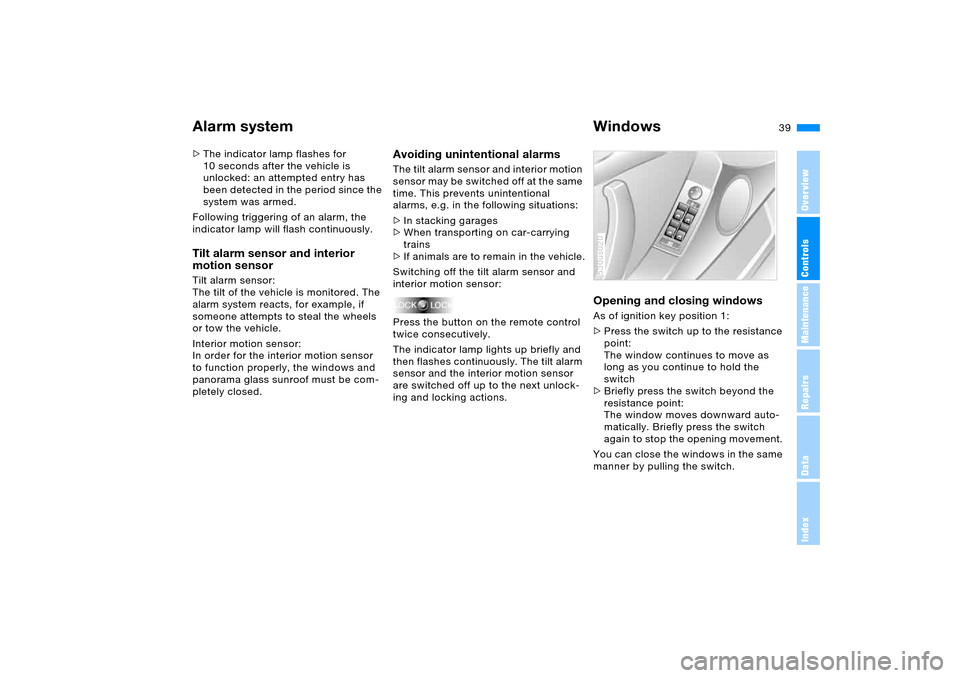
OverviewControlsMaintenanceRepairsDataIndex
39n
Alarm system Windows>The indicator lamp flashes for
10 seconds after the vehicle is
unlocked: an attempted entry has
been detected in the period since the
system was armed.
Following triggering of an alarm, the
indicator lamp will flash continuously. Tilt alarm sensor and interior
motion sensor Tilt alarm sensor:
The tilt of the vehicle is monitored. The
alarm system reacts, for example, if
someone attempts to steal the wheels
or tow the vehicle.
Interior motion sensor:
In order for the interior motion sensor
to function properly, the windows and
panorama glass sunroof must be com-
pletely closed.
Avoiding unintentional alarms The tilt alarm sensor and interior motion
s en sor m ay be swi tch e d off a t t h e sam e
time. This prevents unintentional
alarms, e.g. in the following situations:
>In stacking garages
>When transporting on car-carrying
trains
>If animals are to remain in the vehicle.
Switching off the tilt alarm sensor and
interior motion sensor:
Press the button on the remote control
twice consecutively.
The indicator lamp lights up briefly and
then flashes continuously. The tilt alarm
sensor and the interior motion sensor
are switched off up to the next unlock-
ing and locking actions.
Opening and closing windows As of ignition key position 1:
>Press the switch up to the resistance
point:
The window continues to move as
long as you continue to hold the
switch
>Briefly press the switch beyond the
resistance point:
The window moves downward auto-
matically. Briefly press the switch
again to stop the opening movement.
You can close the windows in the same
manner by pulling the switch.530us020
Page 43 of 200
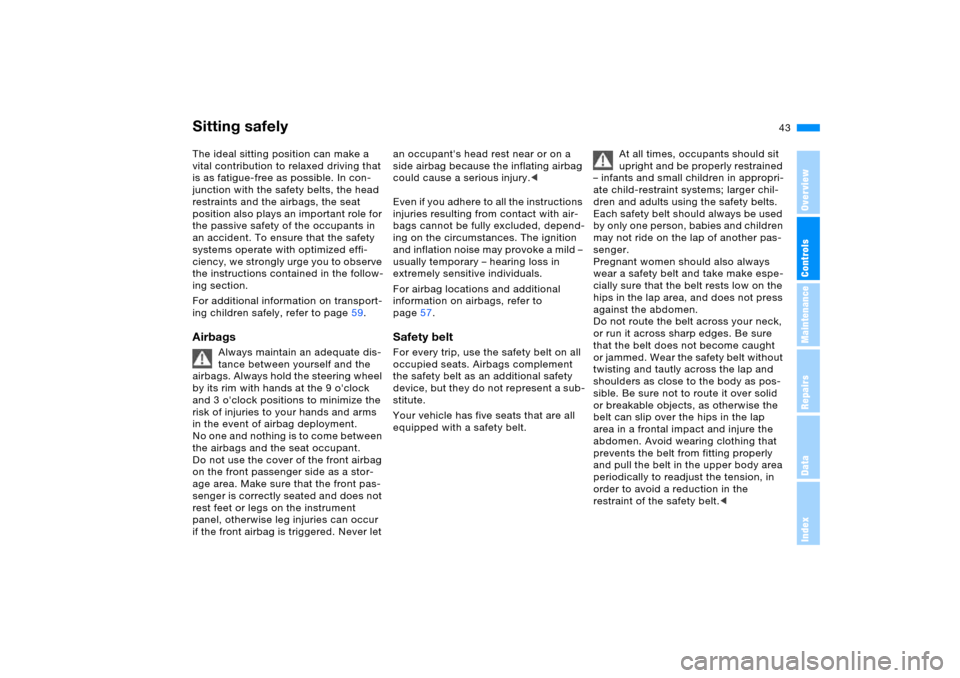
43n
OverviewControlsMaintenanceRepairsDataIndex
The ideal sitting position can make a
vital contribution to relaxed driving that
is as fatigue-free as possible. In con-
junction with the safety belts, the head
restraints and the airbags, the seat
position also plays an important role for
the passive safety of the occupants in
an accident. To ensure that the safety
systems operate with optimized effi-
ciency, we strongly urge you to observe
the instructions contained in the follow-
ing section.
For additional information on transport-
ing children safely, refer to page59.Airbags
Always maintain an adequate dis-
tance between yourself and the
airbags. Always hold the steering wheel
by its rim with hands at the 9 o'clock
and 3 o'clock positions to minimize the
risk of injuries to your hands and arms
in the event of airbag deployment.
No one and nothing is to come between
the airbags and the seat occupant.
Do not use the cover of the front airbag
on the front passenger side as a stor-
age area. Make sure that the front pas-
senger is correctly seated and does not
rest feet or legs on the instrument
panel, otherwise leg injuries can occur
if the front airbag is triggered. Never let
an occupant's head rest near or on a
side airbag because the inflating airbag
could cause a serious injury.<
Even if you adhere to all the instructions
injuries resulting from contact with air-
bags cannot be fully excluded, depend-
ing on the circumstances. The ignition
and inflation noise may provoke a mild –
usually temporary – hearing loss in
extremely sensitive individuals.
For airbag locations and additional
information on airbags, refer to
page57.Safety belt For every trip, use the safety belt on all
occupied seats. Airbags complement
the safety belt as an additional safety
device, but they do not represent a sub-
stitute.
Your vehicle has five seats that are all
equipped with a safety belt.At all times, occupants should sit
upright and be properly restrained
– infants and small children in appropri-
ate child-restraint systems; larger chil-
dren and adults using the safety belts.
Each safety belt should always be used
by only one person, babies and children
may not ride on the lap of another pas-
senger.
Pregnant women should also always
wear a safety belt and take make espe-
cially sure that the belt rests low on the
hips in the lap area, and does not press
against the abdomen.
Do not route the belt across your neck,
or run it across sharp edges. Be sure
that the belt does not become caught
or jammed. Wear the safety belt without
twisting and tautly across the lap and
shoulders as close to the body as pos-
sible. Be sure not to route it over solid
or breakable objects, as otherwise the
belt can slip over the hips in the lap
area in a frontal impact and injure the
abdomen. Avoid wearing clothing that
prevents the belt from fitting properly
and pull the belt in the upper body area
periodically to readjust the tension, in
order to avoid a reduction in the
restraint of the safety belt.<
Sitting safely
Page 50 of 200
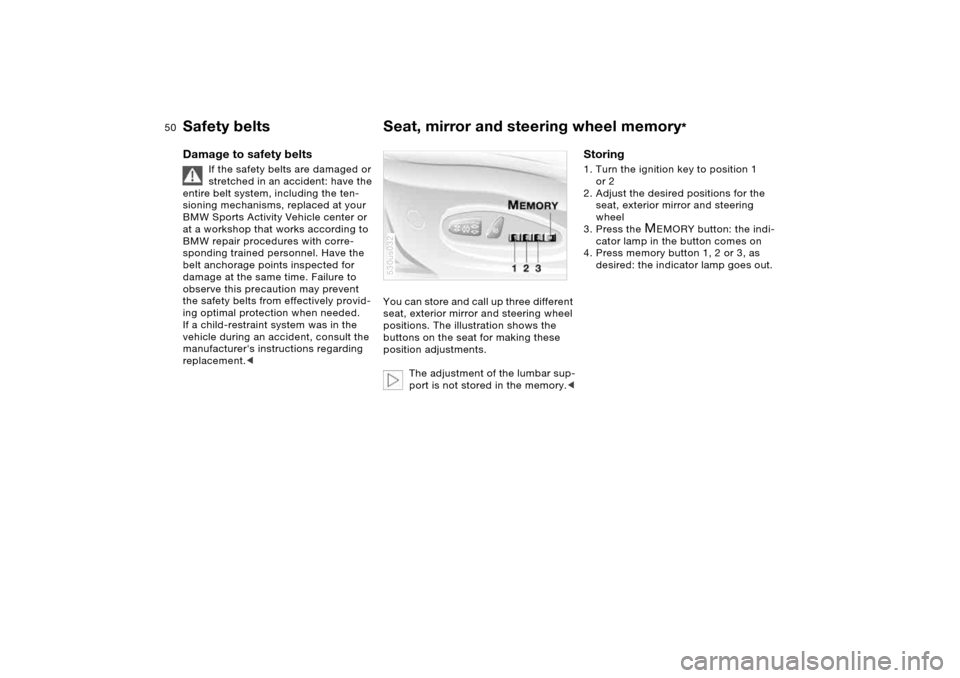
50n
Safety belts Seat, mirror and steering wheel memory
*
Damage to safety belts
If the safety belts are damaged or
stretched in an accident: have the
entire belt system, including the ten-
sioning mechanisms, replaced at your
BMW Sports Activity Vehicle center or
at a workshop that works according to
BMW repair procedures with corre-
sponding trained personnel. Have the
belt anchorage points inspected for
damage at the same time. Failure to
observe this precaution may prevent
the safety belts from effectively provid-
ing optimal protection when needed.
If a child-restraint system was in the
vehicle during an accident, consult the
manufacturer's instructions regarding
replacement.<
You can store and call up three different
seat, exterior mirror and steering wheel
positions. The illustration shows the
buttons on the seat for making these
position adjustments.
The adjustment of the lumbar sup-
port is not stored in the memory.<530us032
Storing 1. Turn the ignition key to position 1
or 2
2. Adjust the desired positions for the
seat, exterior mirror and steering
wheel
3. Press the
M
EMORY button: the indi-
cator lamp in the button comes on
4. Press memory button 1, 2 or 3, as
desired: the indicator lamp goes out.